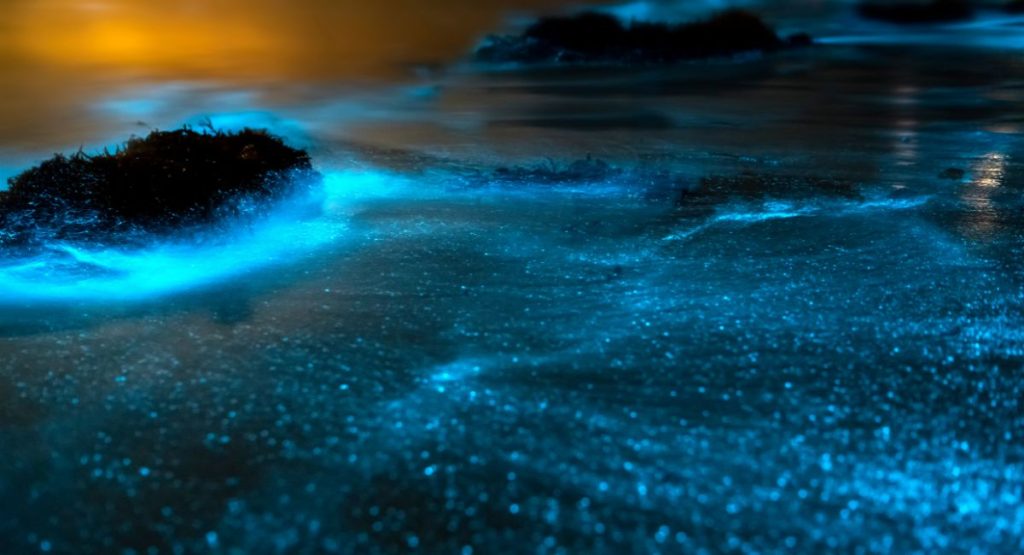Everything To Know About Bioluminescence In San Diego
When picturing the Southern Californian city of San Diego, many people conjure up something other than the bioluminescence phenomenon which occurs bi-annually.
Watching the neon blue light of the marine life brighten up the waves in San Diego is a truly incredible sight to see.
The bioluminescence in San Diego is still an unknown secret to many, and it’s not always guaranteed you’ll see it. We’ve compiled all the information, tips, and tricks you need to know for the best chance at catching it with your own eyes.
Read on for everything to know about San Diego bioluminescence.
You May Also Like: The Best Beaches in San Diego

What Is Bioluminescence and Red Tide?
Bioluminescence is a natural light-producing chemical reaction that occurs in certain marine organisms when disturbed. This phenomenon is not exclusive to sea creatures but is much less common in land animals.
Some bioluminescent species include fish, bacteria, and jellies, though it’s most often associated with algae and, more specifically, plankton.
For this natural process to occur, sea conditions must be calm and warm with little wind. This allows the organisms to grow and multiply quickly.
Bioluminescent algae, though beautiful, can sometimes be harmful to humans and poisonous to fish. This is due to the toxins it can produce. For this reason, avoid swimming with or touching bioluminescent algae; viewing it from the shore is best.
There’s also evidence to suggest this occurrence is a sign of pollution as it can cause low oxygen and high nitrogen levels in the water. This combination allows for rapid growth of toxic algae, which can lead to harmful algae blooms, often referred to as red tide.
There was red tide in San Diego as recently as 2020. This name comes from the red color the poisonous algae causes in the water. Many fish feed on this algae, making them dangerous to humans. The algae causes harmful side effects like sneezing, irritated eyes, bowel complications, and brain function problems.
When Does Bioluminescence Happen in San Diego?
The warm temperatures required for bioluminescence to occur mean the best times to see it in San Diego are from late spring until early autumn. Specifically, February/March and August/September offer the best conditions to witness the glowing blue waters.
Piers or beach breaks are great places to see bioluminescence as the waves crash. The breaks disrupt the algae, which causes them to light up.
Avoiding well-lit areas and waiting until the sky is completely dark can also boost your chances.
It’s worth noting the appearance of bioluminescence depends on various environmental factors which can affect the intensity and frequency of displays.
As a result, there’s no guarantee you’ll see the organisms alight during your San Diego visit. Although it’s believed to be becoming more frequent due to climate change and higher sea temperatures.

Best Places to See Bioluminescence in San Diego
Scripps Pier
One of San Diego’s top spots for catching bioluminescent plankton is Scripps Pier. The pier is located in La Jolla, 15 minutes north of downtown, at the home of Scripps Institution of Oceanography.
Though the pier itself is not open to the public, below the pier is where you want to be. This is where you’ll catch the water come to light as bioluminescent waves crash into the pillars.
It’s best to park along El Paseo Grande, where you’ll be just a few minutes walk to the pier. A popular Instagram spot, Scripps Pier is a fantastic place for keen photographers to snap some pictures of the bioluminescence aglow.
If time permits, arrive at sunset and take a kayak out to sea. You can then watch the sun go down before the sky darkens and plankton becomes visible.
North Torrey Pines Beach
As one of San Diego’s beaches with the least light pollution, Torrey Pines State Beach is among the finest places to see glowing plankton.
Much of this area is part of Torrey Pines State Park, which closes daily at sunset, so be sure to head to the northern part of the beach. This stretch of sand is outside park boundaries and remains accessible after dark.
Arriving after the state park closing time means you cannot park in the lot. However, you can park just outside the reserve, along North Torrey Pines Road, free of charge.
Sightings of bioluminescence here are less consistent than Scripps Pier, but since it’s one of the darkest spots in the city, so you’ve still got good chances.

Sunset Cliffs
Situated in Point Loma, Sunset Cliffs have long been a favorite amongst locals and visitors. Not surprisingly, it’s among San Diego’s most beloved spots to watch the sun go down.
As it so happens, the cliffs along the rugged coastline also make for one of the best places to see the blue glow of the bioluminescent plankton.
Parking is plentiful here, with many free parking lots in the area open 24 hours.
Keep in mind, this can be one of the more crowded locations to experience the vibrant waves. This is largely due to the incredible photo opportunities of the algae hitting the cliffs and lighting up the sea.
Solana Beach
A little further north lies Solana Beach, a picture-perfect coastal city famous for its enviable surfing opportunities and serene vibe.
This area’s quieter, more relaxed nature makes it a wonderful place to see bioluminescent plankton without the crowds.
Finding parking here is easy. There are several free lots near the beach, such as Fletcher Cove Beach Park, though it’s important to remember that some lots close at 10 p.m. each night.
Be aware of the closing times before settling on a spot to avoid finding your car locked in overnight.
Solana Beach is popular with surfers and kayakers. However, taking to the waves at night is only recommended if you’re in the company of fellow surfers and are highly experienced.
Ocean Beach Pier
Ocean Beach is a bustling beachside neighborhood, only a short drive from Sunset Cliffs. Here, you’ll find locals and tourists catching waves, soaking up the sun, and taking in sweeping views of the Pacific Ocean.
After you’ve spent the day catching some rays, head over to the pier as night sets in. You may be able to see the waves crash and break by the pillars, causing the algae to shine.
A stone’s throw away from the pier, you’ll find a free parking lot, though it tends to be quite busy. There’s another parking lot a bit further north, which tends to be quieter; it’s about a 10-minute walk from the dock.

Surfing and Kayaking During Bioluminescence in San Diego
Surfing during bioluminescence is an astounding and unique experience. However, in order to enjoy the surf safely at night, it’s essential to be a confident and competent surfer, and not to go out alone.
Nighttime kayaking is another popular activity to witness the bioluminescent waters up close.
At present, there are no tour companies running excursions at night, so those hoping to kayak must do so without a guide and, therefore, should exercise caution.
As red tides often accompany this phenomenon, some additional precautions must be considered. Research the area you hope to surf or kayak to stay informed of San Diego red tides and possible risks.
How To Photograph Bioluminescence
If seeing bioluminescence with your eyes is challenging, catching it on camera can be even more arduous.
Capturing the magical glow of these organisms requires some preparation, patience, and the right equipment. You’ll also need some good luck on your side!
Here are some tips for the greatest chance of getting the perfect snaps:
- Use a tripod to keep your camera sturdy, which is especially important for long exposure shots.
- A camera with manual settings is preferable to adjust exposure settings.
- Wide-angle lenses are useful for catching the whole scene on camera.
- Ensure the flash is turned off, it can blur and dull the bioluminescence and make it difficult to appear in photos.
- Set your camera to a low aperture to allow more light in and slow the shutter speed.
- Select a low ISO setting to reduce noise in your images.
- Avoid using any bright lights that can impair your night vision.
- Experiment with different settings to get the clearest shot.

San Diego is fortunate to be one of the finest places in the country to experience bioluminescent plankton. Witnessing the majestic natural phenomenon here should be on your bucket list if you plan to visit in the summertime.
Unfortunately, there’s no guarantee the algae will be aglow during your visit. Still, you can increase odds by planning your vacation during early spring or late summer, and staying updated with sea conditions in the weeks before your visit.
We hope you’ve found this helpful in learning about bioluminescence in San Diego.
The post Everything To Know About Bioluminescence In San Diego appeared first on San Diego Explorer.
Categories
Recent Posts

![Things To Do On Halloween in San Diego [2025]](https://img.chime.me/image/fs/chimeblog/289037000021392/60713/20251001/16/w600_original_d7e9ea1a-a50f-4853-9a2f-f3030bf8b80e-jpg.webp)








GET MORE INFORMATION


